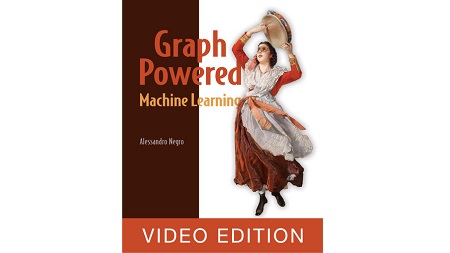
English | MP4 | AVC 1280×720 | AAC 44KHz 2ch | 85 Lessons (12h 34m) | 1.60 GB
I learned so much from this unique and comprehensive book. A real gem for anyone who wants to explore graph-powered ML apps.
Helen Mary Labao-Barrameda, Okada Manila
Upgrade your machine learning models with graph-based algorithms, the perfect structure for complex and interlinked data.
In Graph-Powered Machine Learning you will learn:
- The lifecycle of a machine learning project
- Graphs in big data platforms
- Data source modeling using graphs
- Graph-based natural language processing, recommendations, and fraud detection techniques
- Graph algorithms
- Working with Neo4J
Graph-Powered Machine Learning teaches to use graph-based algorithms and data organization strategies to develop superior machine learning applications. You’ll dive into the role of graphs in machine learning and big data platforms, and take an in-depth look at data source modeling, algorithm design, recommendations, and fraud detection. Explore end-to-end projects that illustrate architectures and help you optimize with best design practices. Author Alessandro Negro’s extensive experience shines through in every chapter, as you learn from examples and concrete scenarios based on his work with real clients!
Identifying relationships is the foundation of machine learning. By recognizing and analyzing the connections in your data, graph-centric algorithms like K-nearest neighbor or PageRank radically improve the effectiveness of ML applications. Graph-based machine learning techniques offer a powerful new perspective for machine learning in social networking, fraud detection, natural language processing, and recommendation systems.
Graph-Powered Machine Learning teaches you how to exploit the natural relationships in structured and unstructured datasets using graph-oriented machine learning algorithms and tools. In this authoritative book, you’ll master the architectures and design practices of graphs, and avoid common pitfalls. Author Alessandro Negro explores examples from real-world applications that connect GraphML concepts to real world tasks.
Table of Contents
1 Part 1 Introduction
2 Machine learning and graphs – An introduction
3 Business understanding
4 Machine learning challenges
5 Performance
6 Graphs
7 Graphs as models of networks
8 The role of graphs in machine learning
9 Graph data engineering
10 Velocity
11 Graphs in the big data platform
12 Graphs are valuable for big data
13 Graphs are valuable for master data management
14 Graph databases
15 Sharding
16 Native vs. non-native graph databases
17 Label property graphs
18 Graphs in machine learning applications
19 Managing data sources
20 Detect a fraud
21 Recommend items
22 Algorithms
23 Find keywords in a document
24 Storing and accessing machine learning models
25 Monitoring a subject
26 Visualization
27 Leftover – Deep learning and graph neural networks
28 Part 2 Recommendations
29 Content-based recommendations
30 Representing item features
31 Representing item features
32 User modeling
33 Providing recommendations
34 Providing recommendations
35 Providing recommendations
36 Collaborative filtering
37 Collaborative filtering recommendations
38 Computing the nearest neighbor network
39 Computing the nearest neighbor network
40 Providing recommendations
41 Dealing with the cold-start problem
42 Session-based recommendations
43 The events chain and the session graph
44 Providing recommendations
45 Session-based k-NN
46 Context-aware and hybrid recommendations
47 Representing contextual information
48 Providing recommendations
49 Providing recommendations
50 Advantages of the graph approach
51 Providing recommendations
52 Part 3 Fighting fraud
53 Basic approaches to graph-powered fraud detection
54 Fraud prevention and detection
55 The role of graphs in fighting fraud
56 Warm-up – Basic approaches
57 Identifying a fraud ring
58 Proximity-based algorithms
59 Distance-based approach
60 Creating the k-nearest neighbors graph
61 Identifying fraudulent transactions
62 Identifying fraudulent transactions
63 Social network analysis against fraud
64 Social network analysis concepts
65 Score-based methods
66 Neighborhood metrics
67 Centrality metrics
68 Collective inference algorithms
69 Cluster-based methods
70 Part 4 Taming text with graphs
71 Graph-based natural language processing
72 A basic approach – Store and access sequence of words
73 NLP and graphs
74 NLP and graphs
75 Knowledge graphs
76 Knowledge graph building – Entities
77 Knowledge graph building – Relationships
78 Semantic networks
79 Unsupervised keyword extraction
80 Unsupervised keyword extraction
81 Keyword co-occurrence graph
82 Appendix A. Machine learning algorithms taxonomy
83 Appendix C Graphs for processing patterns and workflows
84 Appendix C Graphs for defining complex processing workflows
85 Appendix D. Representing graphs
Resolve the captcha to access the links!